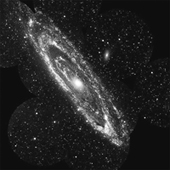
Astronomer Edwin Hubble announces that the spiral nebula Andromeda is actually a galaxy, and our own Milky Way is just one of many galaxies in the universe.
Before Copernicus and Galileo, humans thought our world was the center of creation. After learning that the sun and planets did not revolve around the earth (see here), we discovered that the sun was not the center of the universe or even a major star in its galaxy. Then, astronomer Edwin Hubble knocked us off our egotistical little pedestal once again.

He trained the powerful new hundred-inch telescope at Mount Wilson in Southern California on spiral nebulae. These fuzzy patches of light were generally thought to be clouds of gas or dust within the Milky Way, which was presumed to include almost everything in the universe.
Hubble found not only stars in Andromeda but Cepheid variable stars. He used Henrietta Leavitt’s formula for variable stars to calculate that Andromeda was 860,000 light-years away: eight times the distance to the farthest stars in the Milky Way. This conclusively proved that the nebulae are separate star systems and that our galaxy is not the universe. This cosmic news didn’t make the front page of the New York Times. The paper did notice the following February 25 that Hubble and a public health researcher split a $1,000 science prize ($13,400 in today’s money).
Hubble discovered another couple of dozen galaxies, and by analyzing the Doppler effect on the spectra of receding stars, he established that red shift is proportional to distance. Hubble was honored by being the first to use the two-hundred-inch Mount Palomar telescope (see here) and by NASA naming its space telescope after him.—RA